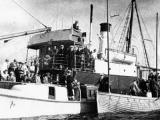What happened that day?
See historic events for any day of the year by entering the date below. Why not try your birthday?
Kiwi of the Week
Today in History

1940 Niagara sunk by German mines off Northland
The Second World War arrived in New Zealand with a bang when the trans-Pacific liner Niagara was sunk by a German mine off the Northland coast. The sinking shocked the public and shattered any illusions that distance alone would protect these islands from enemy attack.
On the night of 13–14 June the German ‘auxiliary cruiser’ (armed merchant raider) Orion had slipped undetected into New Zealand waters and laid 228 contact mines in the northern and eastern approaches to Hauraki Gulf. In the early hours of the 19th, shortly after leaving Auckland on its regular run to Suva and Vancouver, the 13,415-ton liner Niagara struck one of these mines off Northland’s Bream Head. All 349 passengers and crew got away safely in the liner’s 18 lifeboats; the only casualty was the ship’s cat, ‘Aussie’.
More worrying for the authorities was the loss of the ship’s secret cargo of gold ingots worth £2.5 million (equivalent to $220 million in 2011) − almost all later recovered in an epic deep-sea salvage job − and half of New Zealand’s stock of small-arms ammunition, which was being sent to Britain to help replace ammunition lost during the battle for France.
Over the next six months the Orion and another German raider, the Komet, sank a further 11 ships in the Pacific.
Image: A lifeboat from the Niagara transfers survivors to the coastal vessel Kapiti. (NZETC )




















